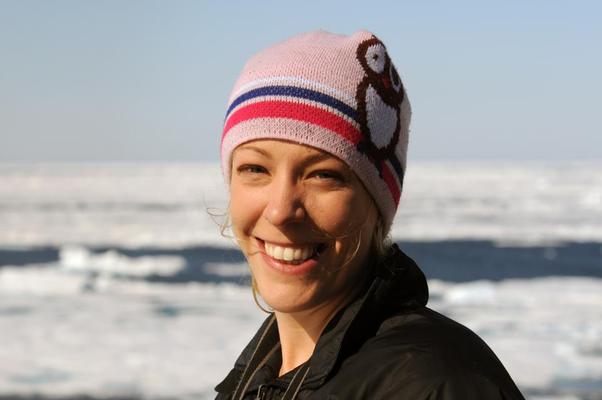
by Kathryn Hansen Thursday, January 5, 2012

Kathryn Hansen is an associate editor at EARTH and writes the CryoScoop blog. Karen Frey
Researchers flying over West Antarctica last month were at the right place at the right time, spotting an actively growing rift that they expect will spawn an iceberg about 10 times the size of Manhattan.
Science teams spotted the massive crack across Pine Island Glacier’s floating ice shelf on Oct. 14 during a routine annual science flight to monitor the region’s ice. Returning to the site for a closer look, scientists used the aircraft’s suite of instruments to produce “the first-ever detailed airborne measurements of a major iceberg calving in progress,” NASA announced on Nov. 1. The surveys were part of NASA’s Operation IceBridge, an airborne mission now in its third year of annual surveys of polar ice. Watch the video from the flight.
The rift measures about 29 kilometers long, at least 50 meters deep, and up to 250 meters wide. When the berg finally breaks free — possibly later this year or early next — an 880-square-kilometer area of ice will be set adrift in the Southern Ocean. Calving events of this magnitude from Pine Island are expected once every five to six years. The most recent significant berg calved in 2007.
Like a glacier on land, the position of a floating ice shelf’s snout — its terminus — is cyclic. For the Pine Island ice shelf, which is fed by a glacier of the same name, the terminus steadily advances and then retreats in a sudden calving event, beginning the advancement phase all over again.
When glaciologist Joe MacGregor of the University of Texas at Austin became aware of the rift, he culled data on Pine Island’s terminus position from publications, recent imagery and imagery from Landsat dating back to 1972. He charted the data and ended up with a seesaw pattern of about five distinct advances and retreats since the late 1980s, when there became enough data to tease out clear cycles. MacGregor’s goal was to show how the pending retreat will compare to past events.
“The pending event is likely to be the largest on record, in terms of retreat of the terminus position,” says MacGregor, noting that the retreat will be about 19.4 kilometers. That tops the previous largest event in 2007, when the shelf calved a berg and the terminus retreated by at least 18.1 kilometers. As far as Antarctic bergs go, the size of ice shed by Pine Island will not set any records. The largest berg currently tracked by the U.S. Navy measures in at about 5,500 square kilometers, dwarfing the expected 880-square-kilometer Pine Island berg.
Scientists are not just interested in the pending berg. The rift, mapped in detail for the first time from aircraft, is revealing clues about the dynamics and evolution of the cracks that grow to rifts and shed bergs. Looking back at satellite data, scientists say that from September to early October, the rift was widening by about 2 meters per day.
“The speed at which the rift grew is remarkable,” MacGregor says. “It doesn't appear that it has occurred that quickly in the past,” he adds, citing work by NASA’s Robert Bindschadler. Of course, MacGregor notes, observations of such events are sparse prior to the late 1980’s, and it could be that scientists are simply paying closer attention to this rift as it evolves before watchful eyes and sensors. “But I doubt it,” he adds.
Still, there’s no reason to believe that the rift’s growth was caused by climate change, says Michael Studinger, NASA project scientist for the IceBridge mission. “It’s an event that we had anticipated, but what makes it exciting is that we just happened to be here and see it happening.” The major story of Pine Island, he says, has more to do with how the dynamics of the entire Pine Island system are changing, particularly its rapid thinning, which moves farther inland every year.
“I prefer to think of the size and timing of this pending iceberg, along with the speed at which the rift propagated, as just the latest in a list of symptoms that Pine Island Glacier’s dynamics are rapidly evolving,” MacGregor adds.
The new, detailed map of the rift could help scientists get a better handle on rift dynamics. A challenge for scientists has been to translate the physics of the rifting process into global ice sheet models, an effort that Studinger calls “far from trivial.” The physics need to be simplified enough to represent reality, but also efficient enough to be useful in continent-wide models, he says. Improving these models will help scientists hone estimates of the continent’s mass balance — ice gained minus ice lost — a key indicator by which scientists can track large-scale change.
Whether the calving event impacts the rate at which Pine Island Glacier loses ice to the sea remains to be seen. “This iceberg breaking off shouldn’t matter much to Pine Island Glacier’s overall dynamics, based on existing glaciological understanding and models specific to Pine Island,” MacGregor says. “However, it would be quite interesting if we were proven wrong.”\
© 2008-2021. All rights reserved. Any copying, redistribution or retransmission of any of the contents of this service without the expressed written permission of the American Geosciences Institute is expressly prohibited. Click here for all copyright requests.